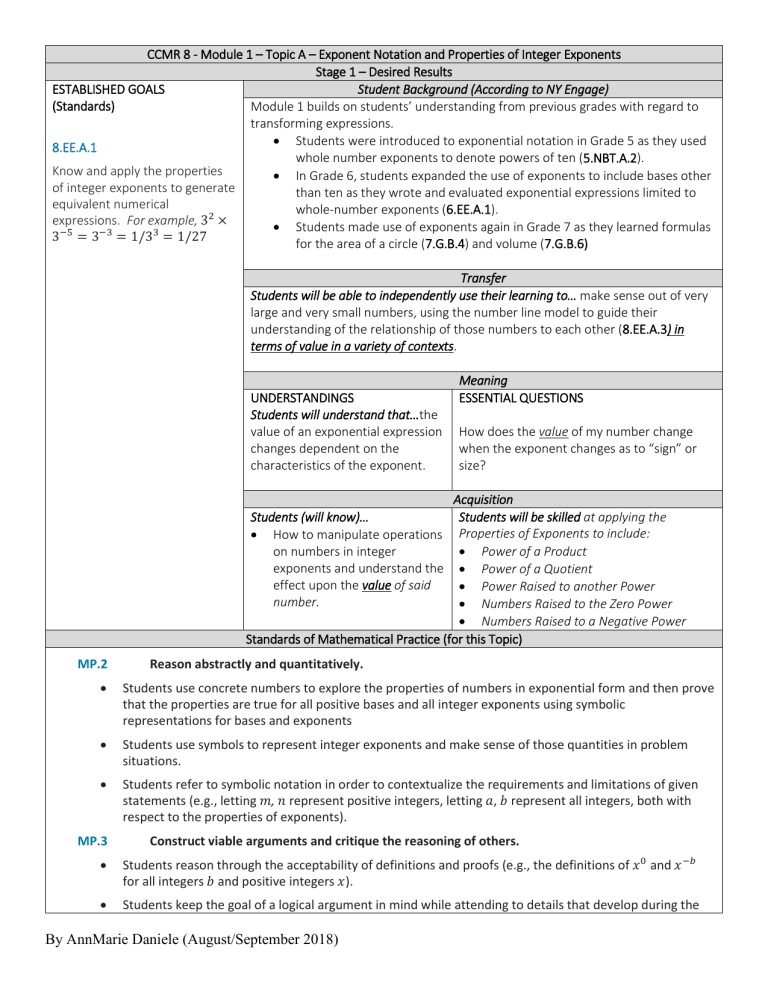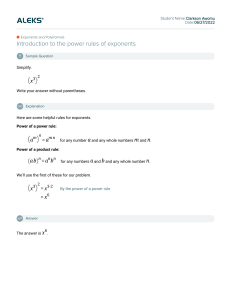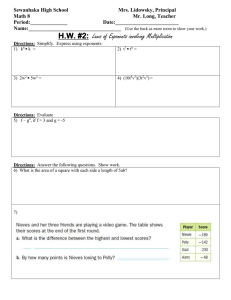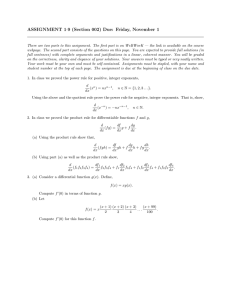
CCMR 8 - Module 1 – Topic A – Exponent Notation and Properties of Integer Exponents Stage 1 – Desired Results ESTABLISHED GOALS Student Background (According to NY Engage) (Standards) Module 1 builds on students’ understanding from previous grades with regard to transforming expressions. Students were introduced to exponential notation in Grade 5 as they used 8.EE.A.1 whole number exponents to denote powers of ten (5.NBT.A.2). Know and apply the properties In Grade 6, students expanded the use of exponents to include bases other of integer exponents to generate than ten as they wrote and evaluated exponential expressions limited to equivalent numerical whole-number exponents (6.EE.A.1). expressions. For example, 32 × Students made use of exponents again in Grade 7 as they learned formulas 3−5 = 3−3 = 1/33 = 1/27 for the area of a circle (7.G.B.4) and volume (7.G.B.6) Transfer Students will be able to independently use their learning to… make sense out of very large and very small numbers, using the number line model to guide their understanding of the relationship of those numbers to each other (8.EE.A.3) in terms of value in a variety of contexts. UNDERSTANDINGS Students will understand that…the value of an exponential expression changes dependent on the characteristics of the exponent. Meaning ESSENTIAL QUESTIONS How does the value of my number change when the exponent changes as to “sign” or size? Acquisition Students will be skilled at applying the Properties of Exponents to include: Power of a Product Power of a Quotient Power Raised to another Power Numbers Raised to the Zero Power Numbers Raised to a Negative Power Standards of Mathematical Practice (for this Topic) Students (will know)… How to manipulate operations on numbers in integer exponents and understand the effect upon the value of said number. MP.2 Reason abstractly and quantitatively. Students use concrete numbers to explore the properties of numbers in exponential form and then prove that the properties are true for all positive bases and all integer exponents using symbolic representations for bases and exponents Students use symbols to represent integer exponents and make sense of those quantities in problem situations. Students refer to symbolic notation in order to contextualize the requirements and limitations of given statements (e.g., letting 𝑚, 𝑛 represent positive integers, letting 𝑎, 𝑏 represent all integers, both with respect to the properties of exponents). MP.3 Construct viable arguments and critique the reasoning of others. Students reason through the acceptability of definitions and proofs (e.g., the definitions of 𝑥 0 and 𝑥 −𝑏 for all integers 𝑏 and positive integers 𝑥). Students keep the goal of a logical argument in mind while attending to details that develop during the By AnnMarie Daniele (August/September 2018) reasoning process. MP.6 Attend to precision. Beginning with the first lesson on exponential notation, students are required to attend to the definitions provided throughout the lessons and the limitations of symbolic statements, making sure to express what they mean clearly. Students are provided a hypothesis, such as 𝑥 < 𝑦, for positive integers 𝑥, 𝑦, and then are asked to evaluate whether a statement, like −2 < 5, contradicts this hypothesis. MP.7 Look for and make use of structure. Students understand and make analogies to the distributive law as they develop properties of exponents. Students will know 𝑥 𝑚 ∙ 𝑥 𝑛 = 𝑥 𝑚+𝑛 as an analog of 𝑚𝑥 + 𝑛𝑥 = (𝑚 + 𝑛)𝑥 and (𝑥 𝑚 )𝑛 = 𝑥 𝑚 ∙ 𝑛 as an analog of 𝑛 ∙ (𝑚 ∙ 𝑥) = (𝑛 ∙ 𝑚) ∙ 𝑥. MP.8 Look for and express regularity in repeated reasoning. While evaluating the cases developed for the proofs of laws of exponents, students identify when a statement must be proved or if it has already been proven. Students see the use of the laws of exponents in application problems and notice the patterns that are developed in problems. Evaluative Criteria Students will be able to apply the properties of integer exponents to generate equivalent expressions and explain their understanding of those “concepts”. Stage 2 – Evidence and Assessment Assessment Evidence PERFORMANCE TASK(S): Students will create a web “study guide page” for Exponents that will summarize and provide examples of their understanding of each of the Properties of Exponents to include examples from other sources (outside of NY Engage). OTHER EVIDENCE: Exit Tickets (Quizzes) after each Lesson 1-5 Topic – Integer Exponent Quiz (PARCC Questions via Edulastic) Stage 3 – Learning Plan Summary of Key Learning Events and Instruction Pre-Diagnostic of Foundational Integer Skills (7th Grade) – printed for each student and shared with parents via notification email (September 2019). Generalized Note-taking using Fold-able Graphic Organizer that summarizes and gives both concrete (numerical) and abstract (variable) examples of each of the Properties of Exponents. Direct Instruction of Key Concepts from Module 1 – Topic A – Lessons 1 – 5 Integrated use of the Simple Calculator to aid students in complex multiplication/division when appropriate to allow students to focus on problem-solving. Guided Practice to include Class Work (Exercises) and some Homework (Problem Sets) Independent Practice – using Integer Operation sprints when appropriate Independent Practice – using Sprints from NY Engage M1 Lesson 4 and Lesson 8 and other sources as appropriate. Integration of C/L Mathia Module 1 as classwork (guided practice) and homework (independent practice). Flexible dynamic (changing) grouping to allow students to benefit from various interactions. PLAN for ongoing, continuous Sprint practice (all occasional quizzes) throughout upcoming quarters to allow students to continue developing both confidence and mastery! By AnnMarie Daniele (August/September 2018)


